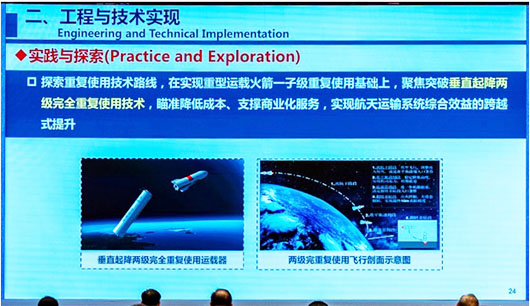Special to CosmicTribune.com, April 20, 2025
By Richard Fisher
April 24 was an active day for the China Aerospace Science and Technology Corporation (CASC); It successfully launched its 20th Shenzhou manned space capsule mission atop its 3.35-meter diameter Long March-3F space launch vehicle (SLV).
New information that surfaced the same day affirmed that its future 10-meter diameter Long March-9 super heavy SLV was inspired by the U.S. SpaceX Corporation’s Starship super heavy SLV.

Shenzhou-20 was the 15th manned mission and the 6th crewed mission to dock with China’s Tiangong Space Station, taking commander and former People’s Liberation Army Air Force (PLAAF) pilot Chen Dong on his third space mission, plus former PLAAF pilot Chen Zhongrui and CASC engineer Wang Jie, both on their first space missions.
The Long March-3F is China’s first man-rated SLV with 20 successful missions and is derived from CASC’s Long March-3 family designed to launch satellites into Geosynchronous Orbit (GEO) with six other variants that have been launched at least 148 times, with seven full or partial failures.
At least in the CASC lineup, the Long March-3F is due to be succeed by a man-rated versions of the 5-meter diameter, and eventually reusable Long March-10, due to start testing in 2026.
Whereas the Long March-3F is well suited to lofting the 8-ton three-astronaut carrying Shenzhou manned spacecraft into Low Earth Orbit (LEO), the Long March-10 will be able to loft up to 50-ton payloads into LEO but to also loft 26-ton payloads into Lunar Transfer Orbit (LTO) to the Moon.
Two Long March-10 missions will be required for the first stage of China’s manned missions to the Moon; one to put the 26-ton Lanyue two-astronaut carrying Moon Landing Vehicle into lunar orbit, and one to loft the 22-ton three-astronaut carrying Mengzhou spacecraft to dock with the Lanyue and transfer two astronauts for the descent to the Moon.
To achieve high payload launching capability, Long March-10 will have a “tri-core” configuration, with a longer central stage that carries manned and unmanned payloads but will also use two “strap-on” stages consisting of first stages of the Long March-10.
Long March-10 “single-core” rockets may become the real successor to Long March-3F for manned missions to LEO, but single-core and tri-core versions will eventually employ reusable first stages to achieve greater efficiencies.
Also on April 24, there was the usual Chinese “cryptic” release of information on its future 10.6 meter diameter Long March-9 super heavy SLV in the form of undated briefing slides revealed on Chinese web pages.
Long March-9 is CASC’s program to compete with the U.S. SpaceX Starship as it basically copies the Starship two-stage configuration with the goal of making both stages reusable, though in its early development the Long March-10 second stage will be expendable.
One slide confirmed earlier Chinese data that the Long March-9 would have a weight of 4,400 tons while its engines would be capable of 6,000 tons of thrust, though while some previous Chinese sources have noted this SLV could put 150 tons into LEO, this slide only notes it can put 100 tons into LEO.
However, it is consistent with previous revelations that Long March-9 can loft up to 50 tons of payload to the Moon, but it also offers the data point that Long March-9 can send 30 tons of payload to Mars.
Full Text . . . . Current Edition . . . . Subscription Information

You must be logged in to post a comment Login